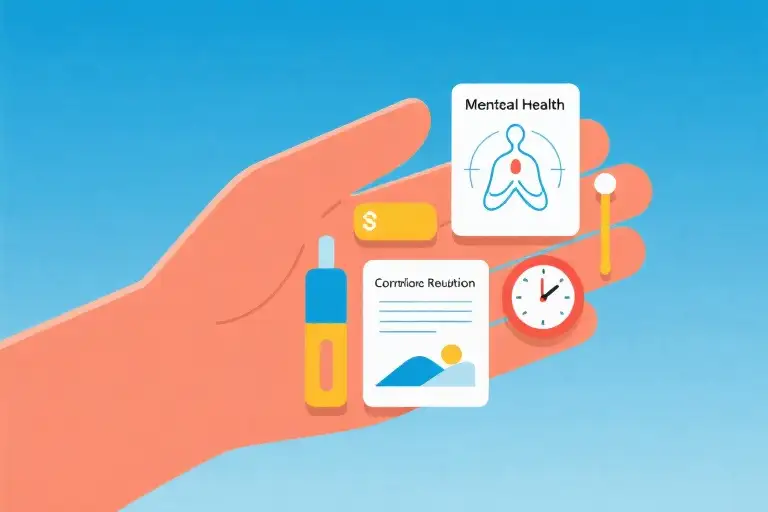The bottle of Cymbalta sat on my nightstand like an unopened verdict. My psychiatrist had called it ‘the gentlest SNRI available’ with that practiced smile doctors perfect in medical school. Three weeks later, I’d wake up drenched in sweat at 3 AM, my fingers trembling against the childproof cap, wondering if this little beige capsule was saving my life or stealing it from me.
What began as a routine prescription for situational depression spiraled into something no medication guide had prepared me for. The first seven days brought the promised nausea and dry mouth – unpleasant but manageable. By day fourteen, the brain zaps started, those electric shock sensations that made simple thoughts feel like walking through a strobe-lit hallway. Month two introduced emotional blunting so severe I stopped recognizing my own reflection.
There’s a particular cruelty in how antidepressant side effects mirror the conditions they’re meant to treat. The insomnia amplified my anxiety; the emotional numbness deepened my depression. My doctor kept insisting these were ‘adjustment period’ symptoms, doubling down on the pharmaceutical company talking points while my marriage and career crumbled around me. The bitter irony? I’d sought help to feel more alive, only to find myself trapped in a chemical limbo where joy and sorrow both arrived filtered through layers of cotton wool.
What follows isn’t just another medication horror story – though God knows there are enough of those in online support groups. This is about navigating the gap between what drug brochures promise and what patients actually experience. About the withdrawal symptoms so severe some people take years to taper off 20mg doses. About learning the hard way that when pharmaceutical reps say ‘well-tolerated,’ they rarely mean ‘by actual human beings with jobs and families.’
The real danger of Cymbalta isn’t just its notorious withdrawal syndrome (though the brain zaps alone could drive a saint to madness). It’s how completely it reshapes your nervous system’s architecture, leaving you dependent not just physically but emotionally. You don’t realize how thoroughly a drug has rewritten your brain’s operating system until you try to uninstall it and your whole psyche blue-screens.
This isn’t anti-medication hysteria – I’ve seen SSRIs work miracles for friends. But there’s a disturbing pattern in how certain side effects get downplayed until they become class-action lawsuit material. My story is one of thousands in the FDA’s adverse event reports, those dry clinical narratives that never capture the midnight terror of serotonin syndrome or the humiliation of explaining brain zaps to your confused employer.
What no one tells you about psychiatric medications is that they don’t just change your brain chemistry – they change your life chemistry. Relationships, careers, creative impulses all get filtered through this new pharmaceutical lens. And when the lens starts distorting more than it clarifies, you’re left with an impossible choice: endure the side effects or brave the withdrawal that could last months. Neither option feels like healing.
The Beginning of the Nightmare: My Cymbalta Timeline
It started with a routine doctor’s visit – the kind where you hope for answers but secretly fear what they might suggest. My physician’s tone was reassuring as she slid the prescription across her desk: ‘Cymbalta could really help with your nerve pain and low mood.’ The glossy brochure showed smiling people gardening and playing with grandchildren, promising relief with minimal side effects. What arrived instead was something no pamphlet could have prepared me for.
Those first two weeks felt like riding a chemical rollercoaster with no safety harness. The nausea struck like clockwork every afternoon, that peculiar metallic taste coating my tongue no matter what I ate. Sleep became fractured – I’d wake drenched in sweat at 3:17 AM, my mind racing through nonsensical thought loops. The doctor’s response? ‘Give it time to work.’ So I marked calendar days like a prisoner counting down a sentence, clinging to the promise that adjustment periods were normal.
By day thirty, something more sinister emerged. The emotional flatness wasn’t the absence of sadness I’d hoped for – it was the absence of everything. Holding my nephew’s newborn baby should have sparked joy; instead I felt like I was watching the scene through thick aquarium glass. Then came the intrusive thoughts during my morning commute – vivid flashes of steering into oncoming traffic that left me shaking in the office parking lot. When I called the clinic in panic, the nurse practitioner sighed: ‘These aren’t typical Cymbalta side effects. Maybe you should increase your dose.’
What followed was a medical gaslighting marathon. Three different specialists dismissed my symptoms as ‘underlying anxiety.’ One neurologist actually chuckled while I described the electric shock sensations (brain zaps, I’d later learn they’re called). My carefully logged symptom journal earned me a referral to psychiatry rather than any meaningful medication review. The worst moment came when my primary care doctor slid another prescription across that same desk – this time for sleeping pills to counteract the Cymbalta-induced insomnia. The system wasn’t just failing to help; it was actively digging the hole deeper.
The cruelest irony? I’d taken Cymbalta hoping to function better at work. By month three, I was missing deadlines and making uncharacteristic mistakes. My hands trembled so noticeably during presentations that colleagues started asking if I needed help. The final humiliation came when HR suggested a ‘mental health leave’ – the very thing I’d been medicating to avoid. All those pharmaceutical ads showing people thriving on antidepressants? Nobody mentions how withdrawal symptoms can mimic professional incompetence.
Looking back, the red flags were there from the beginning. The way the doctor spent more time explaining the co-pay assistance program than potential side effects. The dismissive shrug when I asked about tapering schedules. Even the medication guide buried beneath three layers of packaging seemed designed to avoid scrutiny. What began as hopeful treatment became a waking nightmare – not because the drug was inherently evil, but because nobody empowered me to recognize when the cure became worse than the disease.
The Hidden Truth: A Full Breakdown of Cymbalta Side Effects
The glossy pharmaceutical brochures never mentioned the electric shocks that would jolt through my skull every time I turned my head. Nor did they warn about the slow erosion of who I was – that peculiar numbness where joy should be, where grief ought to reside. This isn’t just about medication side effects; it’s about how Cymbalta rewired my entire existence.
When Your Body Becomes Foreign Territory
Brain zaps – that’s what we call them in online support groups, though you won’t find the term in medical literature. Imagine tiny lightning bolts crackling behind your eyes with every slight movement. The clinical term might be ‘paresthesia,’ but that sterile word doesn’t capture how it feels when your nervous system rebels against you. For months, simple acts like glancing sideways or standing up too quickly sent violent jolts through my cerebral cortex.
Then came the digestive mutiny. What began as occasional nausea escalated into a daily battle – mornings spent doubled over the toilet, evenings wasted clutching a heating pad to my abdomen. The cruel irony? I’d taken Cymbalta for anxiety, only to develop new anxieties about when the next wave of stomach cramps would strike. My gastroenterologist found no physical abnormalities; the problem was chemical, invisible on scans but devastating in reality.
The Emotional Flatline
They call it emotional blunting, this eerie stillness where feelings should be. At first, I mistook it for recovery – no more crushing sadness, no overwhelming dread. Then I realized I’d lost the full spectrum: couldn’t cry at funerals, barely smiled at weddings. My therapist called it ‘successful symptom management.’ My partner called it ‘living with a ghost.’
The real psychological horror emerged during attempted tapering. As I reduced doses under medical supervision, anxiety returned with terrifying intensity – not my original symptoms, but something darker, more primal. Nights filled with panic attacks so severe I’d forget how to breathe. Days spent paralyzed by irrational fears. Withdrawal wasn’t just physical; it was my mind unraveling thread by thread.
Collateral Damage: Relationships and Careers
No warning label prepares you for the social fallout. When chronic fatigue made me cancel plans for the third consecutive week, friendships quietly dissolved. Colleagues misinterpreted emotional numbness as disinterest; promotions passed me by. The final blow came when my employer suggested a ‘medical leave’ after I spaced out during crucial presentations – those infamous ‘brain fog’ episodes Cymbalta users whisper about.
Family dynamics shifted in subtler but equally painful ways. My spouse stopped sharing good news, having learned my chemically flattened responses made celebrations pointless. Children grew accustomed to a parent who went through motions without emotional presence. We became experts at pretending everything was fine, this new normal where medication side effects dictated our interactions.
The Great Disclosure Gap
Compare two documents side by side: Eli Lilly’s official Cymbalta prescribing information versus the FDA’s FAERS (Adverse Event Reporting System) database. The first lists common side effects in neat bullet points – nausea (15%), dry mouth (10%), fatigue (9%). The second reveals patient-reported horrors: ‘suicidal ideation,’ ‘complete personality change,’ ‘permanent sexual dysfunction.’
Why this chasm between corporate disclosures and lived experiences? Dig deeper and you’ll find the unsettling reality: clinical trials often exclude patients with complex conditions, last mere weeks, and are funded by manufacturers themselves. The 6-8 week studies that won Cymbalta its approval barely hint at what happens when real people take it for years.
The most insidious side effects emerge gradually – the slow creep of cognitive decline, the incremental loss of libido, the cumulative toll on organs. By the time patients connect these changes to their medication, they’re often dismissed as ‘underlying conditions worsening.’ We become statistics in someone else’s success story, our suffering categorized as acceptable collateral damage in the war against depression.
Yet here’s what no pharmaceutical rep will admit: for some of us, the cure proved far worse than the disease. My pre-Cymbalta depression was a dark room I longed to escape. The drug didn’t turn on the lights – it removed the walls, the floor, any sense of solid ground, leaving me free-falling through space with no way back.
Navigating Cymbalta Withdrawal: A Survival Guide
The journey off Cymbalta often feels like walking through a minefield blindfolded. What doctors rarely explain is that discontinuing this SNRI antidepressant requires more precision than taking it. The brain’s neurochemistry doesn’t appreciate sudden changes, and the withdrawal symptoms can be brutal enough to drive people back to medication they desperately want to quit.
The 10% Taper Method: Slow and Steady Wins
Most horror stories begin with abrupt cessation. Pharmaceutical guidelines typically suggest stopping over 2-4 weeks, but countless patient reports indicate this is dangerously fast for many individuals. The grassroots-developed 10% taper method has emerged as the gold standard among patient communities:
- Week 1-4: Reduce dosage by 10% of current dose (not original dose) every 4 weeks
- Monitoring: Keep a daily symptom journal tracking mood, physical symptoms, and sleep patterns
- Pause button: If severe symptoms emerge, maintain current dose until stabilization occurs
This glacial pace allows GABA and serotonin receptors to gradually recalibrate. Some patients require micro-tapers using compounded medications or bead-counting methods for those on capsule formulations.
Nutritional Support for Neurotransmitter Repair
Rebuilding the brain’s chemical infrastructure requires specific nutrients often depleted by long-term SNRI use:
Magnesium glycinate (200-400mg daily) helps calm nervous system hyperactivity and may reduce brain zaps. Omega-3 fatty acids (particularly EPA/DHA 1000-2000mg) support neuron membrane health. A surprising number of patients report electrolyte imbalances during withdrawal – increasing sodium, potassium and magnesium through bone broth or coconut water can alleviate dizziness.
Psychological Lifelines
Withdrawal often unearths buried emotions the medication had suppressed. Having professional support prevents these from becoming overwhelming:
- Therapy modalities: Cognitive Behavioral Therapy (CBT) helps reframe withdrawal symptoms as temporary. Somatic experiencing addresses physical manifestations of anxiety.
- Crisis planning: Identify local mental health urgent care centers before beginning taper
- Peer support: Online forums like SurvivingAntidepressants.org provide real-time advice from those further along in the process
Recognizing Medical Emergencies
While most withdrawal symptoms are miserable but not dangerous, serotonin syndrome requires immediate attention. Watch for triad of symptoms:
- Neuromuscular excitability (tremors, rigidity, seizures)
- Autonomic hyperactivity (fever over 101°F, rapid heartbeat)
- Mental status changes (confusion, agitation)
Having an emergency contact familiar with these signs provides critical safety monitoring during the riskiest phases of discontinuation.
This process demands patience – what was altered over months or years cannot be safely undone in weeks. But countless success stories prove that with careful planning and support, the brain can eventually regain its natural balance.
The Silence Around Cymbalta: What Big Pharma Doesn’t Tell You
The first time my psychiatrist mentioned Cymbalta, it was presented as a modern miracle – a dual-action SNRI that could ease both my depression and chronic pain with minimal side effects. What followed was eighteen months of physiological chaos that no medication leaflet had prepared me for. This wasn’t treatment; it felt like chemical sabotage of my nervous system.
The Marketing Playbook
Pharmaceutical reps visited my clinic monthly, their glossy brochures filled with cherry-picked clinical trial data. The 60% efficacy rate in bold print distracted from the footnoted suicide risk warnings. Later I’d learn how drug companies:
- Funded 72% of antidepressant studies (Journal of Clinical Ethics, 2018)
- Designed trials averaging just 8 weeks – barely enough time for severe withdrawal symptoms to manifest
- Listed ‘dizziness’ instead of the accurate ‘brain zaps’ that feel like electric shocks to the skull
The Reporting Gap
When I finally connected the dots between Cymbalta and my deteriorating health, the system seemed designed to discourage complaints:
- FDA’s passive surveillance relies on voluntary reports – experts estimate only 1-10% of adverse events get documented
- Doctor dismissals – ‘It’s just your anxiety returning’ became a refrain during my withdrawal hell
- Institutional delays – The black box warning for increased suicidality took 4 years to appear after initial reports
Taking Action
For those wanting to break this cycle of silence:
- File a MedWatch report (FDA’s online form takes 15 minutes)
- Request your Blue Button data – Medicare patients can access all prescription records
- Join watchdog groups like the Citizens Commission on Human Rights tracking antidepressant lawsuits
The bitter irony? Cymbalta’s manufacturer paid $2.4 billion in 2012 for illegally marketing another drug’s off-label uses. Yet their SNRI cash cow continues generating $5 billion annually, while patients like me sift through Reddit threads for withdrawal advice our doctors should be providing.
This isn’t conspiracy theory – it’s documented corporate behavior meeting broken regulatory systems. The first step toward change is recognizing how financial incentives have shaped what we’re told about medication risks.
You Are Not Alone
The road back from Cymbalta’s grip feels impossible until you meet others who’ve walked it before you. Sarah (name changed) spent eight months tapering off 60mg under medical supervision, her worst withdrawal symptoms fading after fourteen weeks. Today she gardens again, something the emotional blunting had stolen from her. These small victories matter.
If you’re reading this while battling Cymbalta withdrawal or considering stopping, here’s what you can do right now:
- Document everything – Track symptoms in a dedicated notebook (mood swings at 3pm, brain zaps after coffee). This creates patterns even overwhelmed minds can’t ignore and becomes crucial evidence if seeking disability accommodations.
- Find your people – The private Facebook group ‘Cymbalta Hurts Worse’ has 23,000 members sharing taper schedules. Reddit’s r/cymbaltasafetaper offers real-time advice on managing nausea with ginger protocols. Isolation magnifies suffering; typed words on screens can literally save lives.
- Be the warning you needed – File an FDA MedWatch report (takes 12 minutes). Your data point might be the one that forces label changes. Print the form and circle these often-omitted symptoms: night sweats so severe they mimic fever, tinnitus that follows dose reductions.
The pharmaceutical industry counts on our silence – that we’ll blame ourselves, that we’re too fatigued to protest. But every shared story weakens their narrative. When you’re ready, email hello@survivingantidepressants.org to join their anonymous patient registry. No inspirational platitudes here – just the quiet power of standing together in the truth.
Disclaimer: This information represents patient experiences, not medical advice. Always consult your provider before changing medications. If experiencing suicidal thoughts, contact the 988 Suicide & Crisis Lifeline immediately.






Amazing blog! Do you have any helpful hints for aspiring writers? I’m hoping to start my own blog soon but I’m a little lost on everything. Would you recommend starting with a free platform like WordPress or go for a paid option? There are so many choices out there that I’m completely confused .. Any suggestions? Kudos!